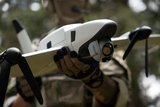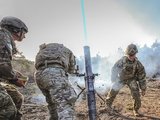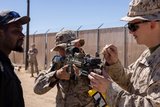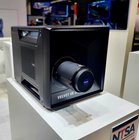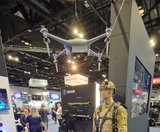First RAAF pilot completes Ghost Bat training
WGCDR Phil Parsons undertaking launch and recovery operations. (Photo: Boeing)
The first Royal Australian Air Force pilot has completed training on a MQ-28A Ghost Bat UAS, becoming the first non-Boeing pilot to complete the training and take control of the aircraft.
Wing Commander Phil Parsons, an experienced remote systems RAAF pilot for the past 10 years, completed Boeing’s training on June 13. As a launch and recovery operator, WGCDR Parsons would oversee launch and recovery of the aircraft, which involves ground preparation, take-off and landing operations.
WGCDR Parsons’ training included observing and monitoring the aircraft as it executed commands to climb and descend, accelerate and decelerate, or navigate to a specific waypoint to achieve test points as part of the current advanced testing programme.
Related Articles
Avalon 2019: Secretive Loyal Wingman breaks cover
Canberra promises to multiply MQ-28A Ghost Bats
MQ-28 Ghost Bat ‘could fit the bill’ for UK's Loyal Wingman capability needs, says Boeing
Glen Ferguson, Boeing Defence Australia MQ-28 program director said the concept of operations was for the pilot to control take-off and landing before handing over to another platform.
“During a typical mission, a launch and recovery operator like WGCDR Parsons would oversee the aircraft as it takes flight,” Ferguson said.
“It would then be handed off to a crewed aircraft, such as an E-7A, F-35A or F/A-18F, whose crew tasks it to perform, for example, an intelligence, surveillance and reconnaissance mission [before] the UAS pilot [oversaw] landing, deceleration and complete stop of the vehicle.”
Ghost Bat is a development of the Boeing Defence Australia’s Airpower Teaming System (ATS) or the 'Loyal Wingman' which was unveiled in 2019 at the Australian Airshow.
It is considered as a multirole platform and features a 1.5 cubic metre nose that will host the platform's payloads. The nose is designed to snap on/off, allowing each UAV to quickly change between a range of payloads that customer requirements will strictly drive.
Since the platform is designed to complement rather than replace existing capability, it will likely carry ISR sensors, EW systems, radars and kinetic weapons, among other payloads.
Related Equipment in Defence Insight
More from Training
-
![Cubic tailors mortar simulator for the US Army]()
Cubic tailors mortar simulator for the US Army
The company’s mortar trainer received improvements based on soldier’s feedback.
-
![Saab expands footprint in the US]()
Saab expands footprint in the US
The company will operate in two new locations in the coming years to better support US services.
-
![How terrain management capabilities can improve military training]()
How terrain management capabilities can improve military training
This type of tool provides more realistic training easing the incorporation of new scenarios that accurately represent the threats of the battlefield.
-
![I/ITSEC 2024: Australian Army approaches second phase of countermining training]()
I/ITSEC 2024: Australian Army approaches second phase of countermining training
The Engineering Corps has been conducting individual instruction using FLAIM Systems’ Sweeper and should start collective deployments in 2025.
-
![I/ITSEC 2024: Zeiss introduces Velvet 4K SIM projector for night flight simulation]()
I/ITSEC 2024: Zeiss introduces Velvet 4K SIM projector for night flight simulation
The next-generation platform is motion-compatible and can be used in OTW and NVG applications.
-
![I/ITSEC 2024: Saab introduces UAV live training capability]()
I/ITSEC 2024: Saab introduces UAV live training capability
The system can be used to prepare soldiers for both drone offensive operations and CUAS missions.









